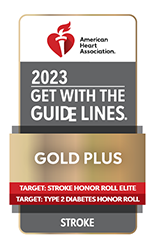California Pacific Medical Center stands at the forefront of treating stroke and neurovascular disorders.
 Our Comprehensive Stroke Care Center provides advanced neurovascular and neurocritical care and rehabilitation from highly trained stroke specialists, increasing your chances of a full recovery.
Our Comprehensive Stroke Care Center provides advanced neurovascular and neurocritical care and rehabilitation from highly trained stroke specialists, increasing your chances of a full recovery.
Our stroke center was awarded the American Heart Association/American Stroke Association Get with The Guidelines Gold Plus Achievement Award, which ensures you receive treatment according to nationally accepted standards and recommendations. The data below highlights our excellent outcomes, including thrombolytic treatment administration and stroke education statistics.









